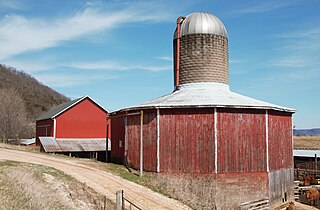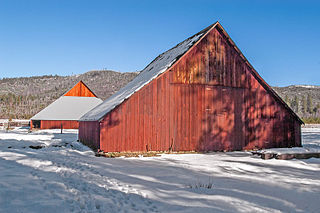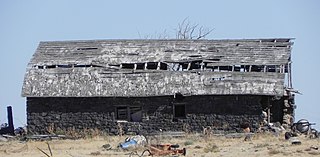
The Charles Fehr Round Barn is a round barn in the U.S. state of Illinois near the Stephenson County village of Orangeville. The barn was built in 1912 by the team of Jeremiah Shaffer and the Haas Brothers about one half mile from the Illinois–Wisconsin state border. The building is the first round barn in the Stephenson County area, home to 31 round barns, with a hip roof. The building was added to the U.S. National Register of Historic Places in 1984.

The Nebergall "Knoll Crest" Round Barn is located between Davenport and Blue Grass in rural Scott County, Iowa, United States. It was built in 1914, and has been listed on the National Register of Historic Places since 1986.

The Thomas Reburn Polygonal Barn is an historic building located near New Albin in rural Allamakee County, Iowa, United States. It was built in 1914 as a beef cattle barn. The building measures 46 feet (14 m) in diameter. It is a 12-sided structure that features red vertical siding and a silo that extends one story through the roof. It is one of four known barns in the round barn genre that was built with a flat or near flat roof in Iowa. It has been listed on the National Register of Historic Places since 1986.

The Grimes Octagon Barn is an historic building located near West Union in rural Fayette County, Iowa, United States. It was built by Joe Butler in 1880 for M.W. Grimes. The building is an octagon that measures 65 feet (20 m) in diameter. It is one of 14 known 19th-century octagon barns that still exist on an Iowa farm. The barn features red metal siding, a roof composed of wedge-shaped sections and a hay dormer. The sectional roof marks it as a Stewart type that was named for the New York farmer and agricultural editor Elliott W. Stewart, who designed the prototype in 1874. The barn has been listed on the National Register of Historic Places since 1986.

The Lenox Round Barn is a historic building that is part of the Taylor County Historical Museum in Bedford, Iowa, United States. The true round barn was built somewhere between 1905 and 1907. The building measures 64 feet (20 m) in diameter and 55 feet (17 m) in height. It features white vertical siding, a large cupola, and a two-pitch roof. The barn was thought to have been designed and built by J.E. Cameron on his farm 5 miles (8.0 km) south of Lenox.

The Dyas Hexagonal Barn is a historical building located near Bellevue in rural Jackson County, Iowa, United States. Built in 1921, it is a round barn measuring 50 feet (15 m) around, with red horizontal siding on a stone foundation, a tin roof, and a central wood stave silo extending through the roof. Despite the common name, the building is actually eight-sided, and is also known as the Dyas Octagonal Barn. Originally the roof was flat or almost flat; it is one of four round barns known to have been built on the same farm. It has been listed on the National Register of Historic Places since 1986.
The Round Barn, Washington Township is a historic building located near Sciola in rural Montgomery County, Iowa, United States. It was built in 1917 as a hog barn. Typical of a barn built for this use in features a multitude of windows on the wall and on the cupola, which provided light and ventilation. The building is a 24-sided structure that measures 60 feet (18 m) in diameter. The barn features red vertical siding, a 12-section cupola, and a two-pitch sectional roof. It has been listed on the National Register of Historic Places since 1986.

The McCauley and Meyer Barns in Yosemite National Park are the last barns in the park that retain their original characteristics as structures built by homesteaders. The McCauley barn and the two Meyer barns represent different construction techniques and styles of design.
W.H. Morgan House was listed on the National Register of Historic Places (NRHP) in 1996. It is located in the Downtown Historic District of Peabody, Kansas.

Neff Round Barn, also known as the Red Round Barn, is a historic round barn located at Potter Township, Centre County, Pennsylvania. It was built about 1910, and is a white pine structure on a limestone foundation. The interior has two floors: the cattle floor and the mow floor. It is 88 feet (27 m) in diameter and 56 feet (17 m) tall at the cupola, encompassing 6,000 square feet. It has a conical roof.
The Thompson-Wohlschlegel Round Barn near Harper, Kansas is a round barn that was built during 1910 to 1913. It was listed on the National Register of Historic Places in 1985, and was delisted in 2020.
The W.S. Kohl Barn near Richfield, Idaho, United States, is a lava rock barn built in c. 1917, probably by skilled stonemason Jack Oughton and by Sandy Reed. Its design appears to be that of a plan advertised by the Gem State Lumber Company of Richfield, and its approximate date of construction is determined by record of farmer W.S. Kohl taking out a mortgage for it in 1917.

The Manuel Silva Barn near Shoshone, Idaho, United States, was built in 1910 by stonemason Ignacio Berriochoa, who lived about 2 miles (3.2 km) away. It was listed on the National Register of Historic Places (NRHP) in 1983.

Greenbank Historic Area is a historic grist mill located at Marshallton, New Castle County, Delaware. The property includes the Greenbank Mill, Robert Philips House, and the W. G. Philips House. The mill was built in 1790 and expanded in 1812. It is a 2+1⁄2 story, frame structure with a stone wing. The mill measures 50 feet (15 m) by 39 feet (12 m). The Robert Philips House was built in 1783, and is a 2+1⁄2 story, five bay, stone dwelling with a gable roof. The front facade features a long verandah. The W. G. Philips House, also known as the mill owner's house, dates to the mid-19th century. It consists of a two-story, three bay front section with a three-story, hipped roof rear section. Oliver Evans, a native of nearby Newport, installed his automatic mill machinery in the 1790 building.
The DeFries House, Barn and Carpenter Shop are a collection of historic buildings located north-west of Andrew, Iowa, United States. They are three of over 217 limestone structures in Jackson County from the mid-19th century, of which 101 were houses, nine were barns, and 36 were other farm-related buildings. The stones used in the construction are of various sizes and shapes and laid in courses. The double end chimneys on the house are found on only two other stone houses in the county, and the DeFries and Thomas Slye houses have them constructed in brick. Also similar to the Slye house is the use of jack arches instead of lintels above the windows and doors. It is possible that both houses were constructed by the same stonemason. While the stonemason for the Syle house is unknown, John Christoph "Christian" Blessing, who was trained in his native Germany, built this collection of buildings for the DeFries family. He completed the house in 1858 and the horse barn in 1862. The carpenter shop was built in either 1858 or 1862.
The Charles M. Prather Barn, near Kingman, Kansas, was built in about 1938 by Charles M. Prather and local carpenters. It was listed on the National Register of Historic Places in 2002.

A Gothic-arched roof barn or Gothic-arch barn or Gothic barn or rainbow arch is a barn whose profile is in the ogival shape of a Gothic arch. These became economically feasible when arch members could be formed by a lamination process. The distinctive roofline features a center peak as in a gable roof, but with symmetrical curved rafters instead of straight ones. The roof could extend to the ground making the roof and walls a complete arch, or be built as an arched roof on top of traditionally framed walls.

The Beamer Barn in Gove County, Kansas, near Oakley, is a Gothic-arch barn which was listed on the National Register of Historic Places in 2010.
The A. O. Huntley Barn, in Adams County, Idaho near Cuprum, Idaho, was built in 1902. It was listed on the National Register of Historic Places in 1978.

The Big John Farm Limestone Bank Barn, located north of U.S. Route 56 and east of Big John Creek in Council Grove, Morris County, Kansas, was listed on the National Register of Historic Places in 1990.














